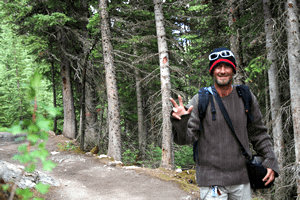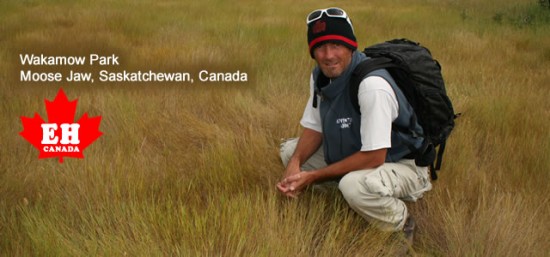

Hiking Rocky Mountains in Alberta, Canada
This coming fall / autumn season is a great time to explore the hiking trails in Canada. The changing colors of fall, the cool breezes, the ocean blue skies and the changing weather can offer up allot of wilderness entertainment.
And… like any good outdoor show preparation is key. Preparing to view our wilderness backcountry entertainment is no exception.
Have you ever gone on a long day hike and as soon as you pass the “point of no return” you noticed you forgot something. I have. Ug! It was a total “Duh” moment! I actually remembered the item but it was empty. The item was bug spray. On that day I was a gift to the mosquito gods.
That is why I have a list of “NOT to FORGET ITEMS” or “MUST HAVES” which I bring with me on every adventure or day trip when hiking in the wilderness backcountry of Canada.
Many of the items have a permanent home located in my day pack so I never forget them. The backpack is my wilderness “tool belt” designed for carrying my camera equipment, my “MUST HAVES” and other specific adventure items required for exploring in the backcountry that day.
Preparing well does not stop the unexpected but it does prepare you well for the unexpected.
So here is a short list of MUST HAVE ITEMS when hiking and walking for a full day in the backcountry of Canada.
- Bug Spray… I like to thank American Express, at least I think it was them, for the quote, “Never Leave Home Without It!” It is a quote made for bug spray. I never leave home without it. Bug spray is a “MUST HAVE” item when exploring remote forests, wetlands, marshlands, birding sites, ocean coastlines, lakes and river valleys in Canada. You may not need it… but when you do, you will thank yourself for it.
- Having no bug spray in the backcountry when it is needed is a bad decision which results in days of unnecessary scratching and itching from bug bites. Depending on the season, location and the weather one may avoid all contact with bugs or one may come in contact with families of mosquitoes or black flies – both are a pain in the butt. It is times like these when bug spray is your best friend especially when you enter, pass through or occupy the lands of the mosquito or black fly.
- Water & Food…. believe it or not the sun shines allot in Canada during most months. Hiking up and down, in and out of forests, up mountains creates sweat. It is a given when hiking you will do allot of it. You need to replenish those liquids lost during hiking with water. No one has super human strength and clear thinking without water. Always pack water.
- And… do not be silly pack some food too on your day hike. A suggestion is to pack food without a scent so not to attract wildlife like granola bars, veggie sticks, nuts, dried fruits, etc. If the food has a scent then wrap it up in freezer bags to minimize the smell. Remember… pack out what you pack in.
- Head & Eye Gear …. protect yourself from the elements. Sunglasses are a must, unless you like to squint all day. For me the type of weather depicts the hat. Many times I pack two types of hats. If it looks like rain in the forecast I pack a waterproof hat with a large rim. If it is cold a toque. If it is hot a baseball hat works for me because it is light weight and small and I can wear it backwards and frontwards depending on the position of the sun thus protecting the back of my neck and my beautiful face when needed.
- Clothing… layer your clothing when hiking. The temperature in Canada can change during a day of hiking due to elevation and weather. If the hike is an elevation hike then as you climb switchbacks and mountain slopes the temperatures may get colder or hotter very quickly.
- Another factor is weather… it changes quickly in some parts of Canada. It can start off hot and finish in cold winds. Putting on clothes and shedding layers of clothing is always a good sign of a full day of wilderness backcountry hiking. It is always good to layer your clothing for your day hike so you can add clothes and remove clothes when necessary to maintain a good comfortable body temperature when exploring.
- Rain Gear … Weather and temperature change fast on some high elevation adventures. The season has allot to do with the elements you may face. Do not get caught without the right protective gear when exploring Canada’s harshest weather elements like wind and rain. You are asking for trouble if the winds pick up, the temperatures drop rapidly or you get caught in a thunder storm, hail storm or rain shower.
- Bear Spray … Never approach wildlife. Never feed wildlife. Never litter leaving a trail for wildlife to follow. Never wear perfumes or colognes. Always be Bear Aware in many parts of Canada. Bear Spray is a good thing to have. Make sure you read how to use it properly. Here is a hint – never spray up wind or else you are bear spraying yourself and that can hurt big time.
- Whistle … We never think it will happen to us is used allot by lost or injured hikers. But what happens if it is your turn for the unexpected… are you ready when you are lost or injured in the wild. A whistle, as simple as it may sound, could save your life. If the unfortunate happens in the backcountry a whistle is key for letting search and rescue teams locate your position. Remember dogs have great scent and hearing and many rescue teams use dogs. Dogs hear whistles very well. Also make note… cell phones may not receive reception in many parts of the wilderness but they sometimes can be used as good tracking devices for pinpointing your location if you are injured or lost.
- Maps or GPS … Getting lost when hiking a full day of long kilometres into the wilderness backcountry because you did not have a trail map, compass or GPS is just plain stupid.
- First Aid Kit … If injury occurs like sprained ankles, bug bites, rashes, sore feet, blisters, sunburn, etc… a small First Aid Kit can go a long way to getting your group back in the mood for adventure or back home to safety for extreme cases. Hint : If for some reason the injury is major and overnight campig is required I pack dryer lint in a zip lock bag. Dryer lint is a great fire starter and it is light weight, easy to pack and easy to start.
- Good Foot Wear … We are amazed at some of the footwear people use for day hikes. We have seen people hike mountains, forests, mud flats, river valleys and Canadian Shield rock in flip flops, high heels, bare feet, dress shoes, etc. It is a recipe for injury. Wear good hiking boots at all times if you can… if not… at least wear running shoes with good traction.
This is my custom list of “MUST HAVE ITEMS”. This would be my selection based on my hiking and backpacking experience exploring hundreds of parks and thousands of wilderness trails in Canada.
There are many other items that some may have on their the list. What would be on your list? |


